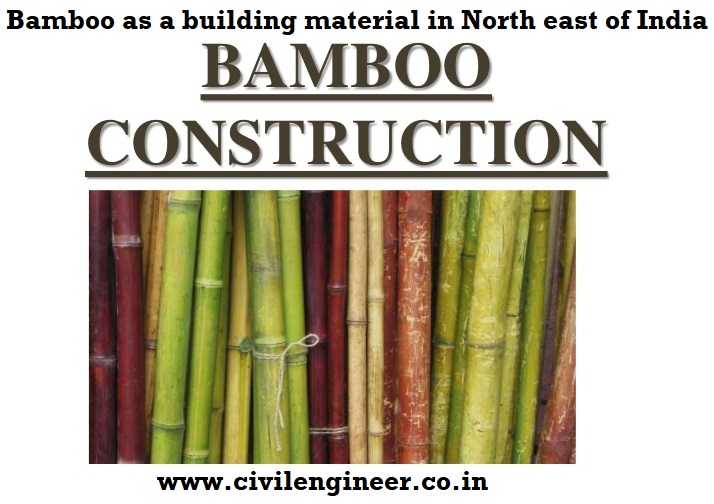
Bamboo as a building material in North east of India
INTRODUCTION
The north eastern region, a landmass of eight states, spread over an area of 262179 Km2 representing around 8% of the total geographical area of the country with a population of about 39.04 million is a region which is abundant in bamboo resources. The region houses about two-thirds of the bamboo resources of the country spreading over an area of about 3.10 million hectares where 89 species of bamboos are available. The main centre for technological input in respect of bamboo is located at Guwahati and it is named as Cane and Bamboo Technology Centre.
Bamboo resource can be used for construction keeping certain points in mind.
POSITIVE IMPACT
- Modulus of Elasticity of bamboo is 1.5 to 2.0 x105 kg/cm² while that of mild steel is 2.1 x 106 kg/cm² thus making it suitable for reinforcement if used after certain treatments.
- Modulus of rupture of bamboo exceeds the corresponding value of sal by 131.38%.
- Safe working stress in compression of bamboo is 105kg/cm2 and the ‘allowable compressive stress’ value has decreased by 20%.
- It can withstand upto 3656 kg/cm2 of pressure.
- There is high content of silicate acid that shows its fire resisting ability.
- Safe working stress in tension of bamboo is 160 to 350 kg/cm2.
- It is three times cheaper then steel reinforcement technique and has similar reinforcing design like steel reinforcement.
- Internodal sections of bamboo is stronger than steel (582 MPa v. ~350 MPa).
 NEGATIVE IMPACT
NEGATIVE IMPACT
- Bamboo is weak at node section so failure can occur.
- It has low modulus of elasticity; in flexural members some cracks are developed.
- When concrete mix proportion technique is used for reinforcement excess water causes swelling of bamboo. In such cases high early-strength cement is preferred to minimize cracks caused by swelling of bamboo when seasoned bamboo cannot be waterproofed.
- When using whole culms, the top and bottom of the stems has to be alternated in every row and the nodes or collars should be staggered otherwise it will lead to non-uniform cross section of the bamboo throughout the length of the member.
- Avoid bamboo cut in spring or early summer. These culms are generally weaker due to increased fibre moisture content.
CONCLUSION
Apart from having negative impact it is more advantageous in earthquake prone areas like North-East as the bamboo material is light in weight. It will also lead to creation of employment opportunities especially for the rural people. It also needs to be noted that bamboo is grown and used in almost all South East Asian countries. China in the present-day world has come out with many advanced technologies and different uses of bamboo. China also has the highest availability of bamboo in the world. India comes next to China.
REFERENCES
- Wikipedia ,”Bamboo construction”- https://en.wikipedia.org/wiki/Bamboo_construction
- International Journal of Science and Research (IJSR), “Use of Bamboo as Building Material”- https://www.ijsr.net/archive/v4i4/SUB153151.pdf
- IOSR Journal of Mechanical and Civil Engineering (IOSR-JMCE), “Replacement of Steel by Bamboo Reinforcement”- http://www.iosrjournals.org/iosr-jmce/papers/vol8-issue1/G0815061.pdf?id=6641
- Bamcore, “Mechanical properties of timber bamboo”- http://bamcore.com/bamboo-info/mechanical-properties-of-timber-bamboo/
- ResearchGate,Conference paper, March 2010,” Indian bamboo as an alternative to timber: A critical evaluation from strength of material perspective”- https://www.researchgate.net/publication/276410333_Indian_bamboo_as_an_alternative_to_timber_A_critical_evaluation_from_strength_of_material_perspective
- Advance in Electronic and Electric Engineering, “Bamboo in Construction Technology”- https://www.ripublication.com/aeee_spl/aeeev4n4spl_04.pdf
- Facets of the North-east, “Bamboo for Economic Prosperity and Ecological Security with Special Reference to North-east India”- http://indianfolklore.org/journals/index.php/Ish/article/download/452/520
